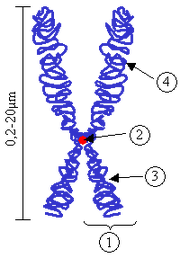Assessment |
Biopsychology |
Comparative |
Cognitive |
Developmental |
Language |
Individual differences |
Personality |
Philosophy |
Social |
Methods |
Statistics |
Clinical |
Educational |
Industrial |
Professional items |
World psychology |
Biological: Behavioural genetics · Evolutionary psychology · Neuroanatomy · Neurochemistry · Neuroendocrinology · Neuroscience · Psychoneuroimmunology · Physiological Psychology · Psychopharmacology (Index, Outline)

Chromosome.
(1) Chromatid. One of the two identical parts of the chromosome after S phase.
(2) Centromere. The point where the two chromatids touch, and where the microtubules attach.
(3) Short arm
(4) Long arm.
A chromatid is one of two identical strands of DNA making up a chromosome that are joined at their centromeres, for the process of nuclear division (mitosis or meiosis). The term is used so long as the centromeres remain in contact. When they separate (during anaphase of mitosis and anaphase 2 of meiosis), the strands are called daughter-chromosomes.The tips of the chromatid are called telomeres.They are there to prevent the ends of the chromosome from attaching to other chromosomes. It has been said that after repeated cell replication, the telomeres gets shorter resulting in cell death. Thus, this mean that the way telomeres work could play a role in determine the lifespan of a cell.However this has not been proven.[1]
In other words, a chromatid is "one-half of a replicated chromosome".[2] It should not be confused with the ploidity of an organism, which is the number of homologous versions of a chromosome.
Etymology[]
The term chromatid was proposed by McClung (1900) for each of the four threads making up a chromosome-pair during meiosis. It was later used also for mitosis.
The term derives from the Greek chroma (colour); for the derivation of -id, see diploid.
References[]
Genetics: chromosomes | |
|---|---|
| General | |
| Classification | |
| Evolution |
Chromosomal inversion - Chromosomal translocation - Polyploidy - Paleopolyploidy |
| Structure |
Chromatin (Euchromatin, Heterochromatin) Histone (H1, H2A, H2B, H3, H4) Centromere (A, B, C1, C2, E, F, H, I, J, K, M, N, O, P, Q, T] Nucleosome - Telomere - Chromatid |
| This page uses Creative Commons Licensed content from Wikipedia (view authors). |